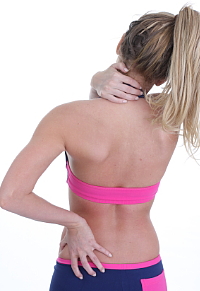- Don’t let sore muscles slow you down.
- Do your muscles get sore a day or two after your workout?
- Treat and Prevent Sore Muscles
What To Do About Sore Muscles
Delayed onset muscle soreness (DOMS) describes muscle pain, muscle soreness or muscle stiffness that occurs in the day or two after exercise. This muscle soreness is most frequently felt when you begin a new exercise program, change your exercise routine, or dramatically increase the duration or intensity of your exercise routine.
Delayed onset muscle soreness is a normal response to unusual exertion and is part of the process that leads to greater stamina and strength as the muscles recover.
This sort of muscle pain is not the same as the muscle pain or fatigue you experience during exercise. Delayed soreness is also unlike the acute, sudden and sharp pain of an injury such as a muscle strains or sprain that occurs during activity and often causes swelling or bruising. The delayed muscle soreness of DOMS is generally at its worst within the first 2 days following a new, intense activity and slowly subsides over the next few days.
What Is the Best Treatment for Muscle Soreness After Exercise?
There is no one simple way to treat delayed onset muscle soreness. In the past, gentle stretching was one of the recommended ways to reduce exercise related muscle soreness, but stretching is not always effective in avoiding muscle soreness.
Nothing is proven 100 percent effective and although some people have found the following advice helpful, it’s best to try a few things to see what works for you. Ultimately, best advice for treating DOMS is to prevent it in the first place.
Using a Foam Roller After Exercise May Help Reduce Soreness
One technique I’ve used with some success to reduce my own muscle soreness is to use a foam roller regularly as a part of my cool down. This has been particularly helpful for me after a long, high intensity bike ride or after I start a new type of exercise or a new weight training routine.
Tips for Dealing with Muscle Soreness After Exercise
If you do find yourself sore after a tough workout, try these methods to deal with your discomfort. Although not all are backed up with research, many athletes report success with some of the following methods.
- Use Active Recovery. Performing easy low-impact aerobic exercise increasing blood flow and is linked with diminished muscle soreness. After an intense workout or competition, use this technique as a part of your cool down.
- Rest and Recover. If you simply wait it out, soreness will go away in 3 to 7 days with no special treatment.
- Try a Sports Massage.
- Try an Ice Bath or Contrast Water Bath.
- Perform Gentle Stretching. Although research doesn’t find stretching alone reduces muscle pain of soreness, many people find it simply feels good.
- Try Yoga. There is growing support that performing Yoga may reduce DOMS.
- Listen to Your Body. Avoid any vigorous activity or exercise that increases pain.
- Allow the soreness to subside thoroughly before performing any vigorous exercise.
- Warm Up completely before your next exercise session.
** If your pain persists longer than about 7 days or increases despite these measures, consult your physician.
Tips to Help Prevent Muscle Soreness After Exercise
While you may not be able to prevent muscle soreness entirely, you may reduce the intensity and duration of muscles soreness if you follow a few exercise recommendations.
- Warm Up thoroughly before activity and cool down completely afterward.
- Cool Down with gentle stretching after exercise.
- Follow the Ten Percent Rule. When beginning a new activity start gradually and build up your time and intensity no more than ten percent per week.
- Hire a Personal Trainer if you aren’t sure how to start a workout program that is safe and effective.
- Start a new weight lifting routine with light weights and high reps (10-12) and gradually increase the amount you lift over several weeks.
- Avoid making sudden major changes in the type of exercise you do.
- Avoid making sudden major changes in the amount of time that you exercise.
Certain muscle pain or soreness can be a sign of a serious injury. If your muscle soreness does not get better within a week consult your physician.
Follow me on facebook – www.facebook.com/coachdwyer


